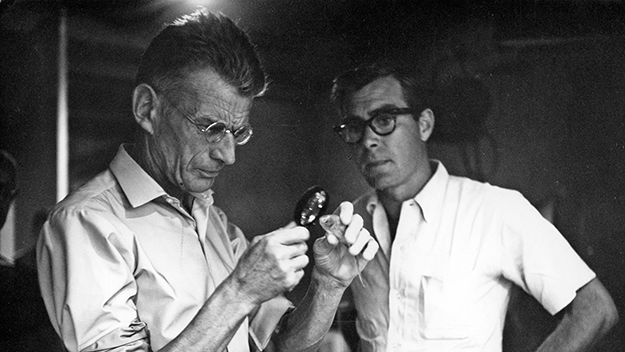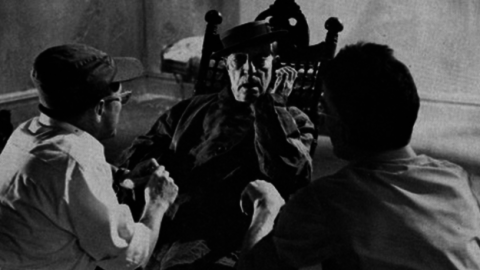Review: Notfilm
Samuel Beckett had the enchanting voice of a natural actor—gentle, paternal, with a brogue that didn’t soften his incisive phrasing. Listening to Beckett’s verbal melody is one of the primary pleasures offered by Ross Lipman’s Notfilm, a lengthy documentary about the making of the playwright’s 1965 Film—a dour 22 minutes of existential panic. Two hours might seem to be overkill for an unsuccessful experimental short, but Notfilm is enthralling.
Lipman shoots his documentary in black and white, and divides it into discrete segments—a section on Beckett, one on Buster Keaton (recruited after Beckett was loftily informed that Charlie Chaplin didn’t act in other people’s scripts, even if they had won the Nobel Prize), one on the production itself, and one on Alan Schneider, the film’s director. Film, which Lipman restored while working on the documentary, is a shaky job, typical of Beckett in that it concerns negation and the difficulty of surviving within that fearful knowledge. Keaton goes about his business with the brisk assurance of a professional, but he was understandably confused by filmmakers who went to the trouble of hiring a comedian but didn’t want him to provide any laughs. Keaton wasn’t in the dread business, but he did his best to give his employers what they wanted, even though he privately thought they were in over their heads. (There is a briefly delightful moment when Keaton is trying to usher a cat and a dog out of the none-too-convincing set that represents his shabby apartment. When the cat goes out, the dog comes in, and vice versa. Surprisingly, the sequence was not Keaton’s contribution, but derived from Beckett’s script.)
Film clearly reveals that Schneider, a director for theater (including American premieres for Beckett’s most celebrated works), had zero aptitude for film. Part of the problem was that he was overawed by Beckett and underawed by Keaton. The director of photography was the great Boris Kaufman (À propos de Nice, On the Waterfront, Splendor in the Grass), but even routine panning shots seem strangely stilted, and Schneider doesn’t have a clue about how to find visual equivalents for Beckett’s prose. (A far better choice would have been Ingmar Bergman, who understood theater and film, and had more than a nodding acquaintance with fear.) Yet the problems visible in the movie were embedded in the affinities of its author. Beckett was an avant-garde minimalist comfortable with the stage, which is intrinsically stylized, but he was helpless before the fact that movies thrive on a layer of behavioral realism that was alien to him.
Lipman talks to the late Barney Rosset, Beckett’s American publisher, who financed Film, as well as the great Billie Whitelaw, the playwright’s primary acting muse. He caught them late, on the downhill slide. Rosset is clearly failing, while Whitelaw is coherent, although she was living in an assisted living facility when she was interviewed. Brisker interviews are offered by Leonard Maltin, who observed the filming for a day; James Karen, who acted in the picture opposite Keaton; and Kevin Brownlow, who interviewed Beckett about the production. Beckett was slightly waspish on the subject of Keaton; he told Brownlow that “Keaton not only had a poker face, he had a poker mind.” It is the (surreptitiously recorded?) tapes of Beckett’s meetings with Schneider, Rosset, and Kaufman that are most revelatory. Schneider and Rosset both approach Beckett on bended knee and don’t nudge him into sharpening his approach for the specific needs of the camera. Kaufman is far more pragmatic, and properly worried; he presses Beckett and Schneider for specifics about converting metaphysical concepts into some kind of physical scenario that he can shoot.
Notfilm has a huge advantage over Film in that its subject is concrete rather than theoretical. Superficially, it’s about the making of a film that even Beckett called “an interesting failure.” But as we witness Rosset and Whitelaw struggling beneath the oppressive weight of age, the documentary becomes about memory and its fading. In other words, the obliteration that awaits us all—the foundation of Beckett’s art.
Notfilm runs April 1 to 7 at Anthology Film Archives.
Scott Eyman has written 13 books about the movies, most recently John Wayne: Life and Legend. He teaches Film History at the University of Miami.








